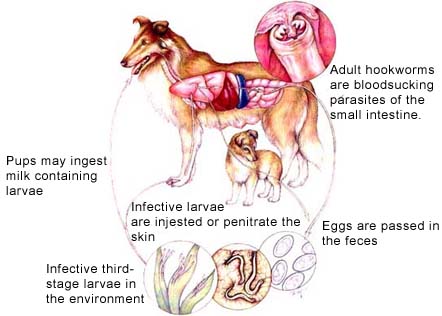Pet Care Articles
Hookworm Infection
Hookworms are small, thin, intestinal parasites that are common in dogs. The canine (dog) hookworm, Ancylostoma caninum, is a voracious bloodsucker. These worms fasten to the wall of the small intestine and suck blood. In cats, hookworm infection is caused by the parasite Ancylostoma tubaeforme. The disease is uncommon, and the parasite is not a bloodsucker.

Dogs become infected with hookworms by four routes:
• Ingestion of soil contaminated with hookworm larvae and eggs (most common method)
• Skin penetration by the hookworm larvae
• Passage of hookworm larvae through the mother's milk to the young puppy
• Infection of the puppy while in the mother's uterus
Young heavily infested puppies generally show severe signs of hookworm infection. Bloody diarrhea, weight loss, weakness, and dehydration are common symptoms. Some animals only develop a slight case of diarrhea, however they appear weak and anemic. Intense blood loss can result in rapid death of young puppies. Hookworm infection in mature dogs usually goes unnoticed. Diarrhea and weight loss are the most common symptoms. These animals are often the source of infection for puppies.
Diagnosis
The diagnosis of hookworm is made by observing the parasite eggs under a microscope. This technique is commonly done at most veterinary hospitals. A small (fresh) stool sample is necessary in order to perform the test.
Treatment
Animals infected with hookworms should be treated with an appropriate medication. In areas where hookworm is a problem, a regular treatment protocol is recommended. Your veterinarian can recommend a treatment that is specific to your pet.
Public Health: Transmission to Humans
The infectious larvae of some hookworm species can penetrate and wander under the skin, causing a disorder known as "cutaneous larva migrans". This condition is extremely uncommon. If cutaneous larva migrans is suspected, a physician should be consulted.
[ Search Articles ] [ Article Index ] [ Previous Page ]

